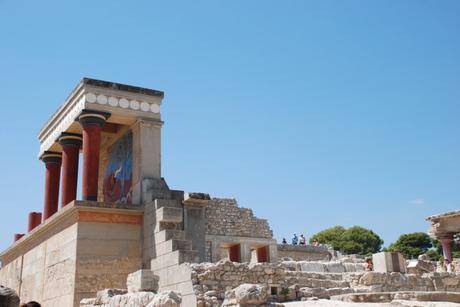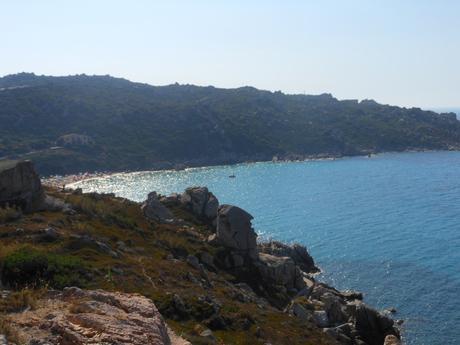
I'm not sure if I've ever shared with you that I double majored in University. One major was management and economics and the other was visual art and art history. It has always been a dream of mine to visit Greece, specifically Crete.
In fact, my husband majored in ancient history in University and his stories from his month long tour of Greece are incredible (as well as his photos). Our son, Zeno (pronounced "Zen- oh"), takes his name from the ancient Greek language, and it literally means "gift of Zeus", which can be interpreted as "gift of God". Tuesday we celebrated his "name day" in Italy and next week we will be visiting Verona in his honor, since the patron Saint of Verona is Saint Zeno!
I've always wanted to visit Crete, which is Greece's largest island and home to the Ideon Cave which was the birthplace of Zeus according to Greek Mythology. It is also home to the Palace of Knossos, which I studied in-depth in University and have dreamed of visiting for years. Did you know that the myth behind the lost city of Atlantis is actually speculated to be the real Minoan Civilisation!
We didn't take a honeymoon when we got married 4 years ago, however, instead of the two of us going somewhere, I would love to plan a family holiday in the sun and investigate some stunning ruins, while exploring Atlantis! Thanks to the number of the affordable deals, we can get to Crete for a great price, and I'm hoping to make this dream a reality and see the Mionoan artifacts in the Heraklion Archaeological Museum in real life by next year.
Today, I invited my friend Collen to share his extensive knowledge of the Minoan culture with us and investigate the Myth of Atlantis, this will also be part of a feature in the Summer edition of the Magazine, enjoy.

Emerging from the Bronze Age around 3,500 to 1,500 BCE, the Minoans were a remarkable people. Some historians have called them "the first link in the European chain" of the Western civilisation - that's a pretty big claim to fame!
The Minoans are believed to have created Europe's first paved roads, and also the first running water supply on the continent. Not only that, but some historians credit the Minoans with producing the early forms of writing and literacy that later produced Greek written language.
The Minoans of Crete
Known as a culture of maritime traders, Minoan civilisation flourished on the island of Crete. There are four main sites today that contain ruins that experts have determined to be from the Minoan era: Knossos, Phaistos, Malia and Zakros.
Knossos
Considered Europe's oldest city, Knossos was the centre of Minoan culture. Archaeologists managed to identify this location thanks to Roman coinage that was scattered in the area. Most coins had "Knosion" or "Knos" inscribed on them, and an image of a Minotaur or a Labyrinth. The mythical King Minos gives his name to both the Minotaur and Minoan civilisation.
Neolithic Knossos was believed to have been destroyed by an earthquake during the Bronze Age, which also affected most other settlements on Crete. The Minoan settlers built a thriving culture in the area, until their civilisation crumbled over a 50 year period.
Phaistos
South of Mount Ida, on the coastline north of the modern settlement of Kommos, lies Phaistos. This settlement is believed to have been a palace complex with ties to Knossos. And similar to its ruling city, several new palaces and villages appear to have been built on top of one another, as natural disasters forced ancient settlers to abandon the original buildings.
Malia
On the north of Crete lies the site of another palace, just north of the modern day village of Malia. Ruins of a village that surrounded the palace were discovered later. Now, you can walk among the ruins in several areas, and there are walkways that allow you to view the other parts from above.
Zakros
On the eastern edge of the island is the site of the palace of Zakros. The ruins of a harbor are nearby, and it is believed that this port area was very important to Minoan trade with nations to the east. Over time, the site has produced a lot of clay tablets with evidence of early written Greek language.

What's the Atlantis connection?
Well, Minoan civilisation is widely held to have been destroyed by a huge volcanic eruption that turned the island of Thera into modern-day Santorini, which is actually the tip of the rim of an undersea volcanic crater. Experts now believe that this explosion would certainly have created tsunami-style waves that swept the area, drowning people, destroying boats, and ruining cropland.
The story of Atlantis comes from an allegory about "ancient Athens" by legendary Greek philosopher Plato. He was known for borrowing pieces of actual history for use in his allegories, and this had led some to believe that the Minoans may have been at least part of the myth. So, there's every chance that Egyptian tales could have shaped Plato's story.
Of course, with sun, sea and superb Greek food available, you won't need to convince your family that Crete is anything other than a "fantastic" holiday location. But with interesting new archaeological sites being discovered year after year, there's plenty of ancient history to enjoy if you want to teach the kids something about the ancient world or even mythology!


